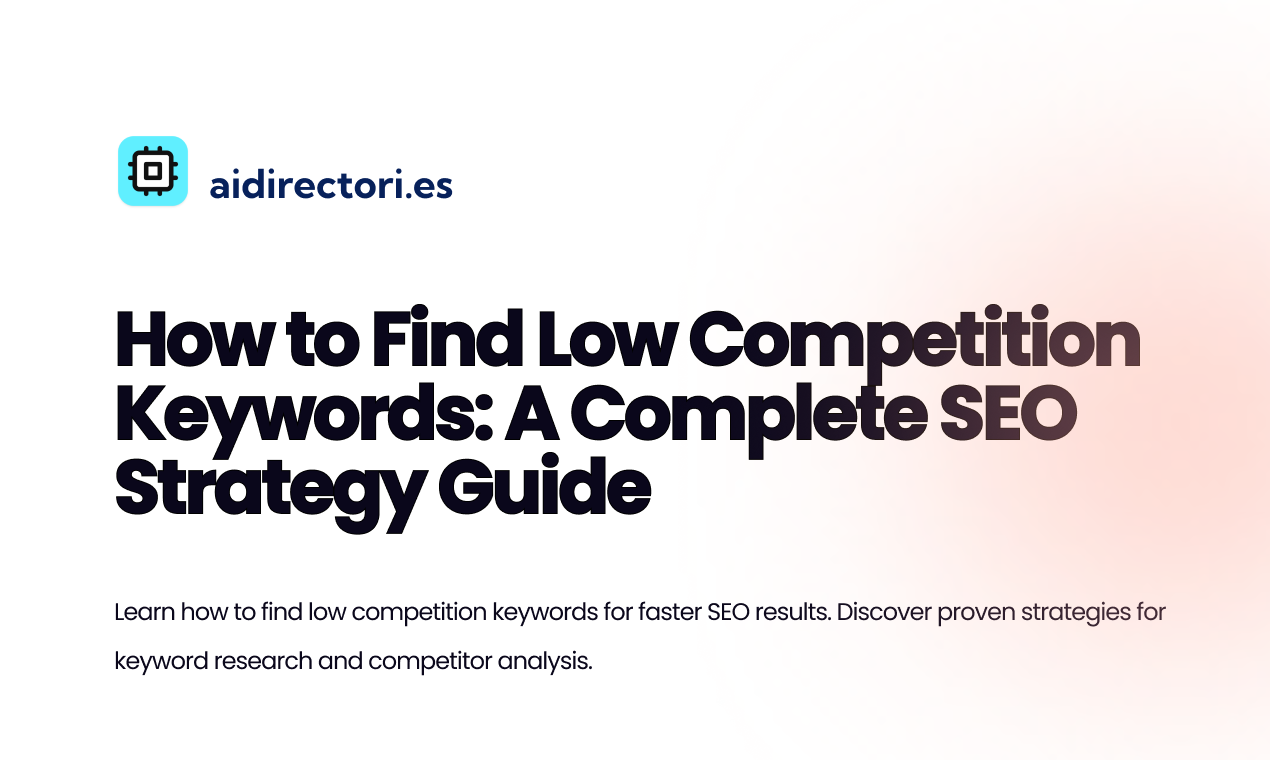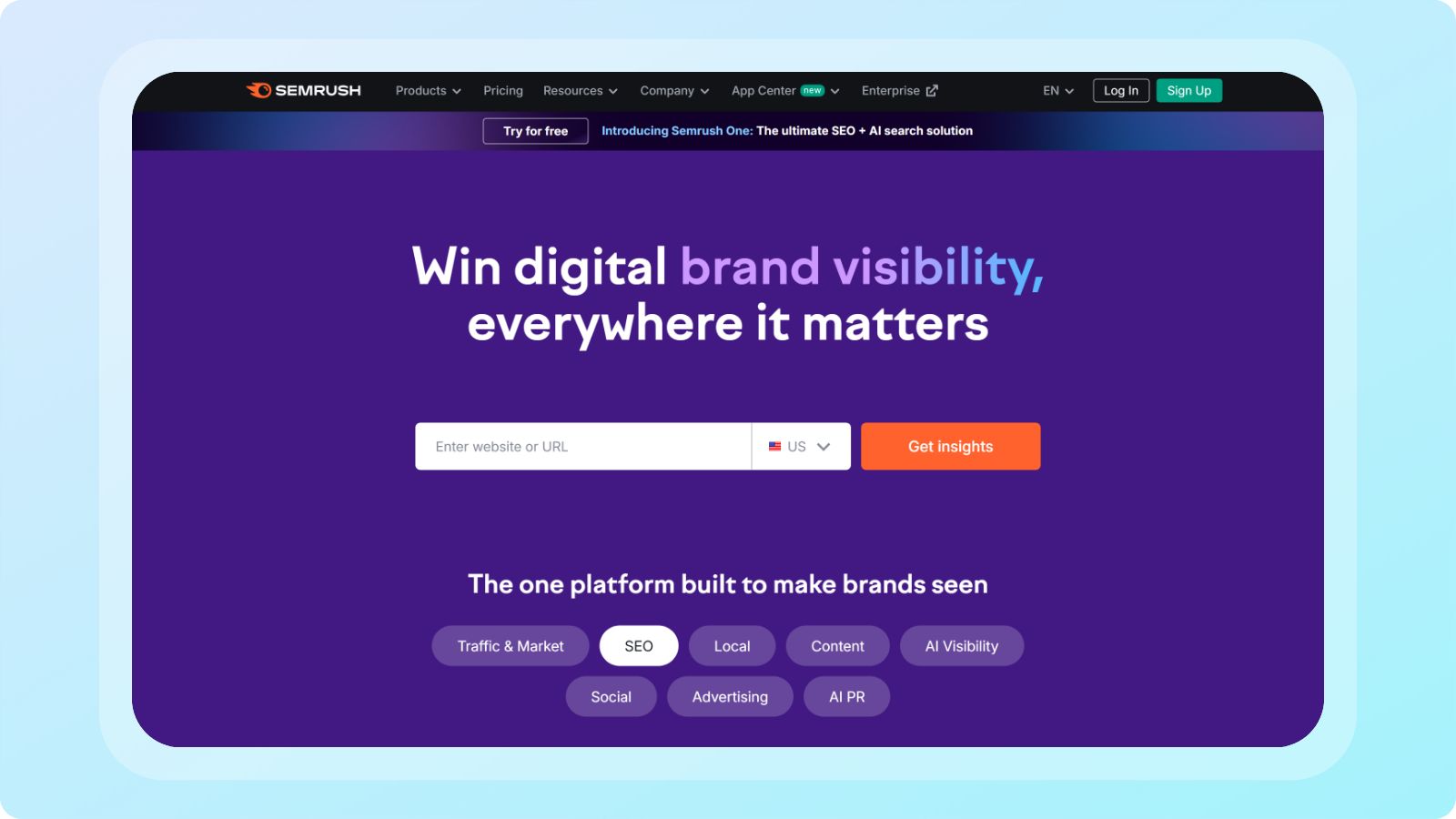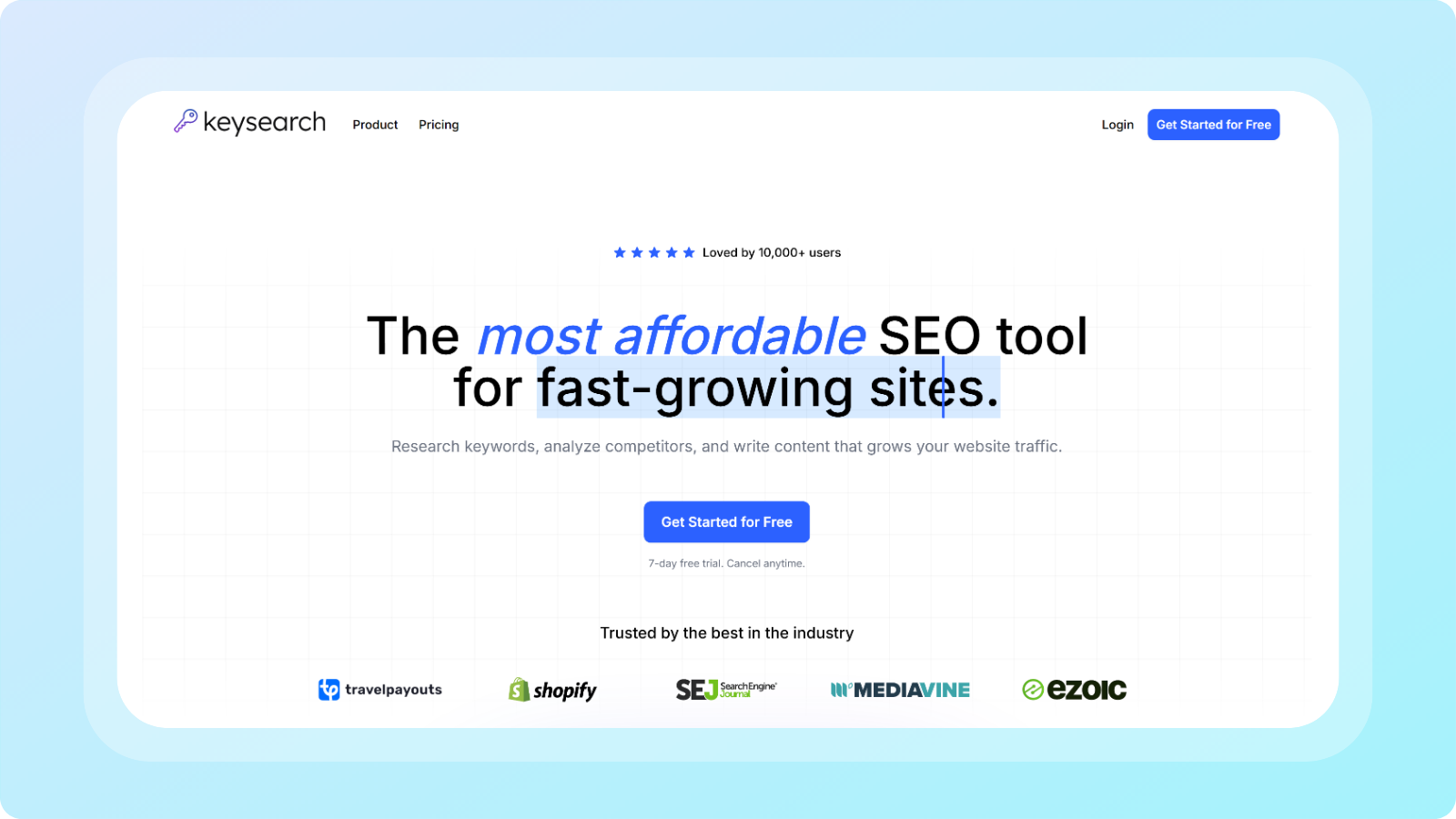How to Find Low Competition Keywords: A Complete SEO Strategy Guide
Learn how to find low competition keywords for faster SEO results. Discover proven strategies for keyword research and competitor analysis.
Posted by
Related reading
Are Manual Directory Submissions Better?
Manual directory submissions vs automation: Why human precision beats ...
NanoPhoto AI Review: Where Artistic Vision Meets AI Brilliance
AI makes video and photo editing simple
Cheap SEO in 2025: 10 Best Tools & Budget Strategies to Rank #1
Top 10 affordable solutions including AI Directories, Ahrefs, Semrush ...
Get your own Review
Let us try and review your product.
- ●Rank on "[your_product] review" on Google and earn a strong backlink
- ●Private feedback from our team to improve your product
- ●Strengthen your customer trust

Finding low competition keywords represents one of the most effective strategies for achieving SEO success without massive budgets or extensive authority. While many businesses chase highly competitive terms that require years of effort and substantial resources, smart SEO practitioners focus on identifying keyword opportunities that offer realistic ranking potential with targeted effort.
The key to successful keyword strategy lies not in pursuing the highest search volume terms, but in discovering valuable keywords where your content can realistically compete and win. This approach enables faster results, better ROI, and sustainable organic growth that builds momentum over time.
This comprehensive guide reveals proven strategies for identifying low competition keywords that drive qualified traffic, exploring advanced techniques that go beyond basic keyword difficulty scores to uncover genuine ranking opportunities in competitive markets.
Understanding Keyword Competition Beyond Basic Metrics
Moving Past Difficulty Scores
Keyword difficulty scores provide helpful directional guidance but shouldn't be the sole factor in keyword selection decisions. These metrics offer a high-level competitive assessment, similar to checking weather forecasts before planning outdoor activities. However, just as local conditions can differ from broader forecasts, individual ranking opportunities often exist even in seemingly competitive keyword spaces.
Experienced SEO professionals treat difficulty scores as starting points rather than final verdicts. A keyword marked as "difficult" might actually present excellent opportunities if top-ranking pages contain outdated content, miss key user needs, or fail to fully address search intent.
Assessing Your Site's Ranking Potential
Your website's current authority level significantly influences ranking potential for any given keyword. Established websites with higher domain authority typically find it easier to rank for competitive terms, similar to how established businesses can better compete in crowded markets.
However, newer sites with lower authority aren't completely excluded from competitive rankings. They simply need different strategic approaches, focusing on building authority through less competitive keywords before gradually targeting more challenging terms. This measured approach creates sustainable growth patterns that compound over time.
Finding Hidden Opportunities in "Difficult" Keywords
Some keywords with high difficulty scores actually present excellent ranking opportunities when analyzed more deeply. This occurs when top-ranking content is low quality, misaligned with search intent, or too broad for specific user needs.
For example, while "best hiking boots" might be highly competitive, variations like "best hiking boots for narrow feet" or "best waterproof hiking boots under $200" could offer solid search volume with significantly less competition. Understanding specific searcher needs reveals these hidden opportunities.
Strategic Approaches to Low Competition Keywords
Long-Tail Keyword Discovery
Long-tail keywords represent multi-word phrases that mirror natural search behavior, offering less competition while driving highly targeted traffic that converts better. Rather than broad single terms like "shoes," users search for specific phrases like "best waterproof hiking boots for women."
While individual long-tail keywords may have lower search volumes, collectively they comprise the majority of online searches. Capturing traffic from several targeted long-tail terms often produces better results than ranking for one competitive head keyword.
Advanced Long-Tail Research Techniques
Effective long-tail discovery starts with analyzing competitor keywords using tools like Semrush's Organic Research feature. This reveals specific phrases competitors rank for, highlighting gaps you can target strategically.
The Keyword Gap tool extends this analysis by identifying terms competitors rank for that you haven't yet covered, revealing immediate content opportunities. Additionally, keyword research tools can expand core topics into long-tail variations. Entering "content marketing" into Semrush's Keyword Magic Tool generates related phrases like "content marketing strategies for small businesses" or "how to create engaging content marketing videos."
Competitor Gap Analysis
Finding low competition keywords requires understanding what competitors are doing and, more importantly, what opportunities they're missing. This involves analyzing competitor keyword strategies to identify gaps you can fill strategically.
For example, while competitors might rank for broad terms like "digital marketing," they may overlook specific phrases like "digital marketing for sustainable fashion brands." These longer, more specific keywords often have less competition while attracting qualified visitors.
Tools like Semrush's Keyword Gap feature help spot overlooked opportunities by comparing your site against multiple competitors, revealing unused opportunities in busy markets.
Validating Keyword Opportunities
After identifying potential low competition keywords through competitor analysis, validation becomes essential. Consider factors beyond just difficulty scores, including search intent, business relevance, and conversion potential.
A low competition keyword with high volume provides little value if it doesn't match what your audience needs. Focus on keywords that align with your business goals while offering realistic ranking potential based on your current authority level.
Essential Keyword Research Tools
Comprehensive SEO Platforms
-
Semrush: Provides extensive keyword data including search volumes, difficulty scores, and competitor analysis. The Keyword Magic Tool helps find long-tail variations while competitor analysis reveals strategic gaps.

-
Ahrefs: Offers detailed keyword metrics and exceptional backlink analysis, helping understand the link profile needed to rank for specific terms. This data proves crucial for identifying truly achievable keyword opportunities.

-
KeySearch: A budget-friendly option providing solid keyword data and competitor analysis features with clean filtering capabilities, particularly effective for finding low-competition terms.

Building Effective Research Workflows
No single tool provides complete keyword intelligence. Smart SEO practitioners use multiple platforms together to verify data and gain comprehensive views of keyword opportunities.
For example, generate initial ideas in Semrush, then use Ahrefs to analyze backlink profiles of top-ranking pages. This assessment helps determine competitive requirements and whether keywords are realistically achievable.
Create systematic processes that include regular research sessions, ranking tracking, and competitor monitoring. Google Search Console provides valuable data about which keywords already drive traffic, helping spot optimization opportunities.
Aligning Keywords with User Intent
Understanding Search Intent Categories
Search intent falls into four main categories that determine content requirements:
- Informational: Users seeking specific knowledge or general information
- Navigational: Users looking for particular websites or pages
- Transactional: Users ready to make purchases or take action
- Investigational: Users researching before making decisions
Understanding these intent types helps create appropriate content that matches user expectations and search engine preferences.
Matching Content to Intent
Analyze top-ranking pages for target keywords to understand what content formats Google considers most relevant. If "best running shoes" returns mostly comparison articles, single product pages probably won't rank well.
Pay attention to writing styles, content depth, and user experience elements that characterize successful pages. Following similar patterns while adding unique value improves ranking potential significantly.
Identifying High-Intent, Low Competition Keywords
Real opportunities exist in keywords combining low competition with strong purchase intent. Focus on long-tail keywords in your niche that reveal clear user intent and buying signals.
Rather than targeting broad terms like "coffee," focus on specific phrases like "best coffee beans for espresso machines" that narrow competition while targeting buyers with specific interests and higher conversion probability.
Implementation Strategy
Keyword Prioritization Framework
Focus on carefully selected subsets of low competition keywords rather than attempting to target everything simultaneously. Evaluate each keyword based on search volume, business relevance, and user intent alignment.
Consider a handmade jewelry business: while "handmade earrings" gets more searches, "handmade silver filigree earrings" shows clearer buying intent, making it a smarter target despite lower volume.
Content Planning and Creation
Build content calendars that map priority keywords to specific content pieces. Consider what information or solutions searchers need, then create content that directly addresses those requirements.
Focus on comprehensive, helpful content that thoroughly addresses user intent rather than keyword-stuffed pages that provide minimal value.
Performance Tracking and Optimization
Monitor content performance using Google Search Console and Google Analytics, tracking rankings, organic traffic, and conversion rates to understand what works.
If content targeting specific keywords isn't gaining traction after reasonable timeframes, consider whether it needs updates, different approaches, or better optimization.
Low Competition Keyword Strategy: Pros and Cons
| Pros | Cons |
|---|---|
| Faster Results | Lower Individual Volume - Each keyword may drive less traffic than highly competitive terms |
| Better ROI | Research Intensive - Finding quality low competition keywords requires significant analysis time |
| Targeted Traffic | Constant Monitoring - Competitive landscapes change, requiring ongoing keyword research and adjustment |
| Sustainable Growth | Limited Scalability - Eventually need to target more competitive terms for continued growth |
| Lower Costs | Niche Dependence - Success may be limited to specific market segments rather than broad audiences |
| Market Gaps | Patience Required - Building authority through low competition terms takes time before tackling bigger opportunities |
Frequently Asked Questions
Q: What is considered a low competition keyword? A: Low competition keywords typically have difficulty scores below 30-40 (depending on the tool used) and feature top-ranking pages with lower domain authority, fewer backlinks, or content that doesn't fully satisfy search intent.
Q: How long does it take to rank for low competition keywords? A: Low competition keywords can show ranking improvements within 2-8 weeks for newer sites, and even faster for established websites with existing authority. Results vary based on content quality and optimization.
Q: Can low competition keywords drive significant traffic? A: While individual low competition keywords may have lower search volumes, targeting multiple related long-tail terms can collectively drive substantial, highly targeted traffic that often converts better than broad keywords.
Q: What tools are best for finding low competition keywords? A: Semrush, Ahrefs, and KeySearch are excellent options. Free tools like Google Keyword Planner and Ubersuggest can also help, though they provide less detailed competitive analysis.
Q: Should I only target low competition keywords? A: Start with low competition keywords to build authority, then gradually target more competitive terms as your site gains strength. A balanced approach combining both strategies works best long-term.
Q: How do I know if a keyword is worth targeting? A: Evaluate keywords based on search volume, competition level, business relevance, user intent alignment, and your site's current authority. Focus on keywords that match your capabilities and business goals.
Q: What's the difference between low competition and long-tail keywords? A: Low competition refers to keywords with less ranking difficulty, while long-tail refers to longer, more specific phrases. Many long-tail keywords are low competition, but not all low competition keywords are long-tail.
Conclusion
Finding low competition keywords offers a proven pathway to SEO success that doesn't require massive budgets or extensive domain authority. This strategic approach enables businesses to achieve meaningful organic growth by focusing on realistic opportunities rather than chasing impossible competitive battles.
The key lies in understanding that effective keyword strategy transcends simple difficulty scores, requiring comprehensive analysis of user intent, competitor gaps, and your site's current capabilities. By combining thorough research with systematic implementation, businesses can build sustainable organic visibility that compounds over time. For insights on tools to help you achieve this, check out our blog: "Cheap SEO in 2025: 10 Best Tools & Budget Strategies to Rank #1".
Success with low competition keywords demands patience, strategic thinking, and consistent execution. However, this approach provides the foundation for long-term SEO growth that eventually enables competition for more challenging terms. Smart businesses start with achievable keyword opportunities while building the authority and expertise needed for future competitive success.
Exclusive offers
Get traffic from web directories.